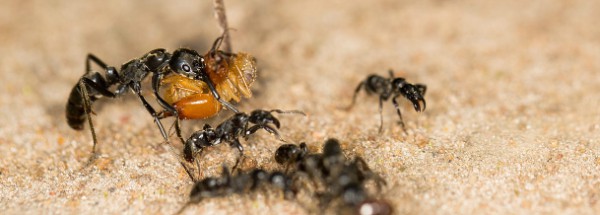Are we smart enough to know how smart animals are?

Frans de Waal asks: are we smart enough to know how smart animals are?
Just as attitudes of superiority within segments of human culture are often expressions of ignorance, humans collectively — especially when subject to the dislocating effects of technological dependence — tend to underestimate the levels of awareness and cognitive skills of creatures who live mostly outside our sight. This tendency translates into presuppositions that need to be challenged by what de Waal calls his “cognitive ripple rule”:
Every cognitive capacity that we discover is going to be older and more widespread than initially thought.
In a review of de Waal’s book, Are We Smart Enough to Know How Smart Animals Are?, Ludwig Huber notes that there are a multitude of illustrations of the fact that brain size does not correlate with cognitive capacities.
Whereas we once thought of humans as having unique capabilities in learning and the use of tools, we now know these attributes place us in a set of species that also includes bees. Our prior assumptions about seemingly robotic behavior in such creatures turns out to have been an expression of our own anthropocentric prejudices.
Various doctrines of human cognitive superiority are made plausible by a comparison of human beings and the chimpanzees. For questions of evolutionary cognition, this focus is one-sided. Consider the evolution of cooperation in social insects, such as the Matabele ant (Megaponera analis). After a termite attack, these ants provide medical services. Having called for help by means of a chemical signal, injured ants are brought back to the nest. Their increased chance of recovery benefits the entire colony. Red forest ants (Myrmica rubra) have the ability to perform simple arithmetic operations and to convey the results to other ants.
When it comes to adaptations in animals that require sophisticated neural control, evolution offers other spectacular examples. The banded archerfish (Toxotes jaculatrix) is able to spit a stream of water at its prey, compensating for refraction at the boundary between air and water. It can also track the distance of its prey, so that the jet develops its greatest force just before impact. Laboratory experiments show that the banded archerfish spits on target even when the trajectory of its prey varies. Spit hunting is a technique that requires the same timing used in throwing, an activity otherwise regarded as unique in the animal kingdom. In human beings, the development of throwing has led to an enormous further development of the brain. And the archerfish? The calculations required for its extraordinary hunting technique are based on the interplay of about six neurons. Neural mini-networks could therefore be much more widespread in the animal kingdom than previously thought.
Research on honeybees (Apis mellifera) has brought to light the cognitive capabilities of minibrains. Honeybees have no brains in the real sense. Their neuronal density, however, is among the highest in insects, with roughly 960 thousand neurons—far fewer than any vertebrate. Even if the brain size of honeybees is normalized to their body size, their relative brain size is lower than most vertebrates. Insect behavior should be less complex, less flexible, and less modifiable than vertebrate behavior. But honeybees learn quickly how to extract pollen and nectar from a large number of different flowers. They care for their young, organize the distribution of tasks, and, with the help of the waggle dance, they inform each other about the location and quality of distant food and water.
Early research by Karl von Frisch suggested that such abilities cannot be the result of inflexible information processing and rigid behavioral programs. Honeybees learn and they remember. The most recent experimental research has, in confirming this conclusion, created an astonishing picture of the honeybee’s cognitive competence. Their representation of the world does not consist entirely of associative chains. It is far more complex, flexible, and integrative. Honeybees show configural conditioning, biconditional discrimination, context-dependent learning and remembering, and even some forms of concept formation. Bees are able to classify images based on such abstract features as bilateral symmetry and radial symmetry; they can comprehend landscapes in a general way, and spontaneously come to classify new images. They have recently been promoted to the set of species capable of social learning and tool use.
In any case, the much smaller brain of the bee does not appear to be a fundamental limitation for comparable cognitive processes, or at least their performance. Jumping spiders and cephalopods are similarly instructive. The similarities between mammals and bees are astonishing, but they cannot be traced to homologous neurological developments. As long as the animal’s neural architecture remains unknown, we cannot determine the cause of their similarity. [Continue reading…]
Don’t miss the latest posts at Attention to the Unseen: Sign up for email updates.